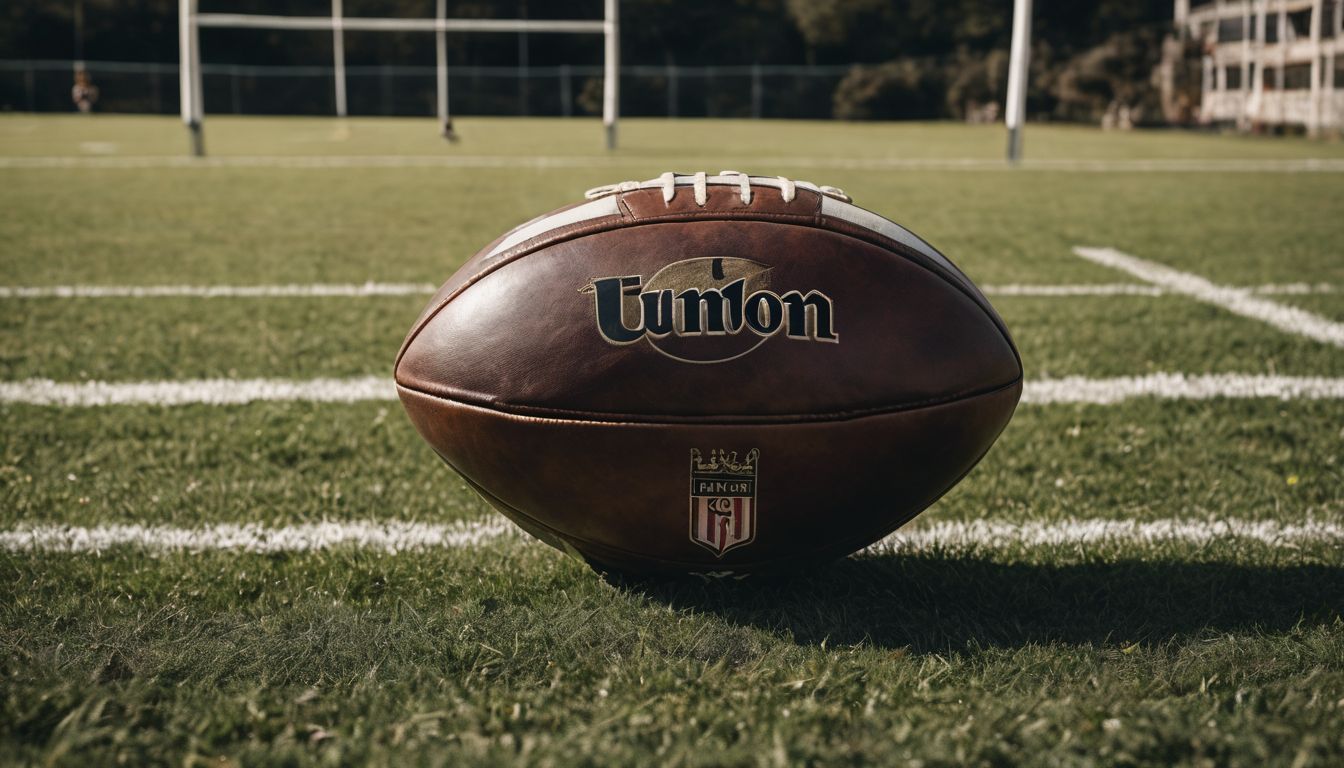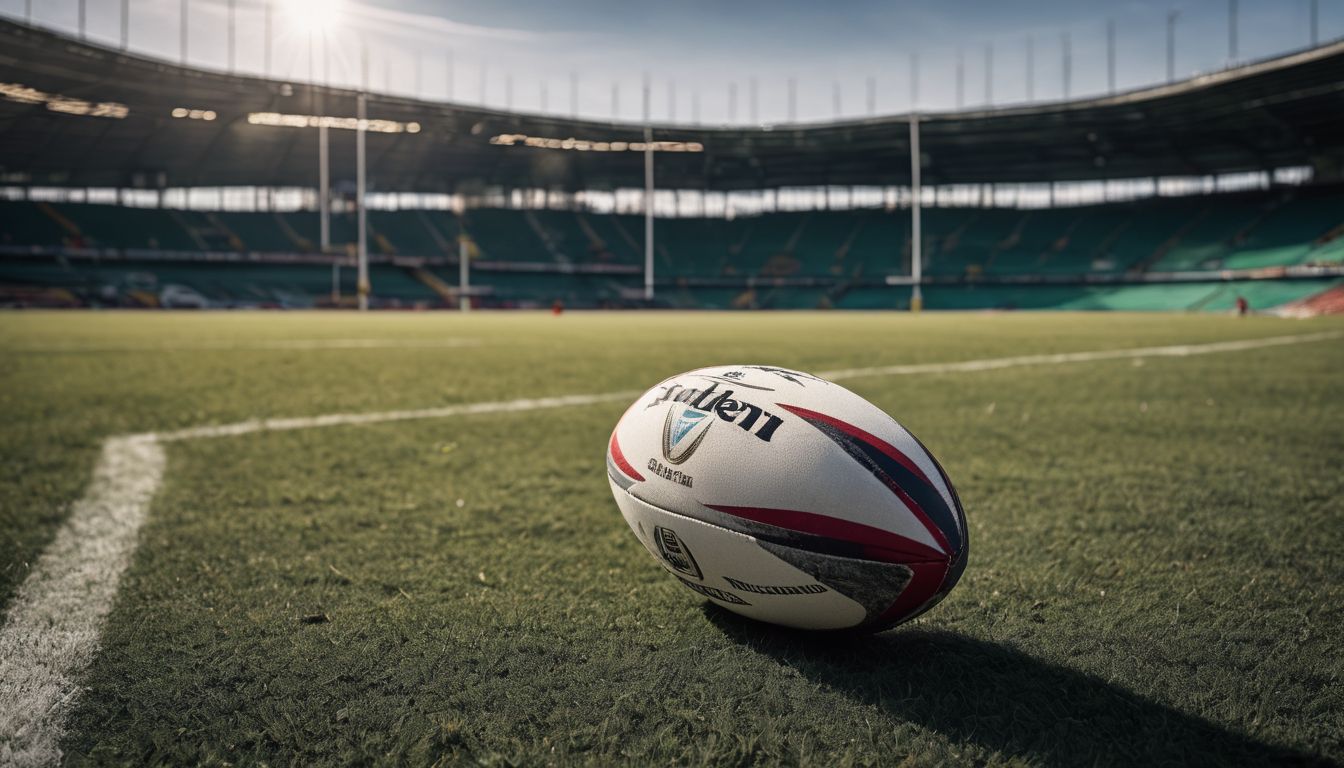Ever wondered why rugby players cluster after a tackle? The breakdown is the heart of rugby, where possession can flip in an instant. This article breaks down (pun intended) the complexities of this crucial phase, equipping you with the know-how to appreciate each contest on the pitch.
Dive in and let’s unlock the secrets of the breakdown together!
Key Takeaways
- The breakdown is a phase in rugby after a tackle where teams compete for the ball, and it’s key to determining who controls possession and can score points.
- Key players at the breakdown include the tackled player who must release the ball, supporting teammates securing possession, and opponents looking to steal it.
- Techniques like clearing out opponents, counter – rucking to regain control, and proper presentation of the ball back to one’s team are vital at the breakdown.
- Rule changes have shaped how the breakdown is played with emphasised fair contest for possession while fitness levels affect players’ performance during these phases.
- Successfully navigating the breakdown influences game outcomes by impacting possession, territorial advantage, momentum shifts and maintaining disciplined play.
Understanding the Breakdown in Rugby
The breakdown in rugby refers to the phase of play where the ball-carrier is tackled and players from both teams contest for possession. Key players involved in this phase include the ball carrier, supporting players, and opposition players looking to steal or secure possession.
This phase is crucial as it often determines who will have control of the ball and ultimately score points in the game.
Definition of breakdown
In rugby, a breakdown happens the moment play is disrupted due to a tackle. Players from both teams hustle to gain control of the ball as it hits the ground. This crucial phase follows right after a tackle and can lead into a ruck if players from each side make contact above the ball on the ground.
At this point, quick thinking and swift action are essential: tackled players must release the ball and their teammates must protect it to maintain possession or risk a turnover.
Breakdowns set the stage for either team to reorganise and launch new attacks or bolster their defence. Rugby fans know that what unfolds during these brief moments can drastically influence which team commands the field.
Skills in contesting for possession at the breakdown are vital for every player, shaping how effectively they can support their team’s strategies throughout match play.
Key players involved
The key players involved in the breakdown are the tackled player, who must release the ball, and the supporting teammates who strive to secure possession. It is crucial for the tackler to effectively bring down their opponent, while simultaneous support from teammates ensures a swift recovery of possession.
The ability of these players to accurately execute their roles directly impacts the team’s offensive or defensive strategy during a game.
Communication among players is fundamental in organising tactical movement around the breakdown area. Each player has specific responsibilities that contribute to either retaining possession or contesting for turnovers.
Importance in the game
The breakdown in rugby is crucial as it directly impacts possession and territory. It provides the opportunity for a team to secure the ball or create turnovers, which can lead to scoring opportunities.
Success at the breakdown also contributes to gaining momentum and dictating the pace of the game. Moreover, discipline is paramount during this phase of play, as penalties conceded at the breakdown can significantly influence the outcome of a match.
Understanding and excelling at the breakdown enables teams to control possession, apply pressure on opponents, and create try-scoring chances. Therefore, players must be adept in executing effective techniques such as clearing out and presentation of the ball while also being vigilant with defensive strategies like counter-rucking.
Techniques Used in the Breakdown
Techniques used in the breakdown include clearing out, counter-rucking, and presentation of the ball. Each of these plays a crucial role in securing possession and creating scoring opportunities for the team.
Clearing Out
The technique of “Clearing Out” in rugby is crucial for maintaining possession and gaining an advantage during the breakdown. It involves the following techniques:
- Players must quickly and forcefully drive away opponents from the ball after a tackle to secure possession.
- The aim is to create space around the ball carrier, enabling quick presentation of the ball and preventing turnovers.
- Effective communication among teammates is essential for coordinating clearing out efforts and ensuring a smooth transition of play.
- Timing and coordination are key in executing successful clearing out to maintain control of the ball.
- Players need to be physically strong and conditioned to effectively clear out opponents from the breakdown area.
Counter-Rucking
Counter-Rucking
- Players use their strength and timing to drive into the opposition’s ruck, aiming to dislodge and steal the ball.
- This aggressive tactic requires quick thinking and precise execution to destabilise the opposition’s formation.
- Effective counter – rucking can create turnovers, providing valuable opportunities for attacking play.
- It demands coordination among teammates, with players working in unison to overpower and outmuscle their opponents at the breakdown.
- A well-executed counter-ruck can shift momentum in a game, turning defensive situations into potential scoring opportunities for the attacking team.
Presentation of the Ball
To secure possession during the breakdown, the tackled player must release the ball and make sure it is presented back to their team. This involves placing the ball towards their own team while on the ground, using precise body positioning and controlled movements to ensure that it’s easily accessible for a teammate.
The art of presenting the ball is crucial in maintaining possession and preventing turnovers, making it an essential skill for players to master.
Players need to practice working hard on the ground to get the ball presented back effectively; this includes using techniques such as rolling away from opponents or placing the ball strategically behind them.
Strategies for Attack and Defense
Attack tactics include quick, efficient rucking and support play, while defensive tactics focus on disrupting opposition possession through aggressive tackling and contesting the breakdown.
Learn more about these strategies and their impact on the game by reading the full blog!
Attack tactics
To effectively attack during the breakdown in rugby, players can employ several tactics:
- Support Play: Players should quickly arrive at the breakdown to provide support to the ball carrier and secure possession.
- Ball Presentation: The tackled player must release the ball and present it back to their team efficiently.
- Quick Recycling: Players need to swiftly recycle the ball from the breakdown area to maintain momentum and create scoring opportunities.
- Off-the-Ball Movement: Supporting players must move into positions where they can receive and maintain possession after the breakdown is resolved.
- Communication: Clear communication among teammates is crucial for coordinating attacking movements from the breakdown.
Defensive tactics
In rugby, defensive tactics in the breakdown are crucial to regain possession and disrupt the opposition’s attack. Here are some key defensive tactics used in the breakdown:
- Counter-Rucking: Defending players aim to disrupt the attacking team’s ruck by driving over the ball and forcing turnovers.
- Protecting Space: Players must cover gaps around the breakdown area to prevent attackers from exploiting weaknesses.
- Communication: Defenders need to effectively communicate to ensure coordinated efforts in securing possession or slowing down the attacking team’s play.
- Body Positioning: Players use body angles and positioning to apply pressure on the opposition, making it difficult for them to secure clean ball.
- Decision Making: Defenders make quick decisions on whether to commit players to contest for the ball or spread out defensively based on game situations.
- Physicality: The defensive team must match or surpass the physicality of the attacking team in order to win back possession and maintain control in the breakdown.
- Anticipating Offside Lines: Defenders need to position themselves intelligently at the offside line, ready to put pressure on opponents while remaining within legal boundaries.
- Discipline: Maintaining discipline is critical as infringements at the breakdown can result in penalties, which can be costly for a defending team.
- Contest for Possession: Defenders strive to legally contest for possession without giving away penalties or compromising their position on the field.
- Readjustment: After each phase of play, defenders readjust their positions quickly and efficiently according to how events unfold during a game.
Evolution of the Breakdown
The breakdown in rugby has evolved over the years due to rule changes, improved fitness and conditioning, and the use of video analysis. To learn more about how these factors have impacted the game, keep reading!
Rule changes
Rule changes in rugby have significantly impacted the breakdown over the years. The laws around tackling, offside lines, and what players can do on the ground have been modified to create a fairer contest for possession.
One significant change is that players are now required to attempt to grasp for the ball immediately after making a tackle instead of rolling away or getting up first. This has led to increased competition at the breakdown and emphasised the importance of strong supporting players and efficient presentation of the ball.
Another notable rule change involves sealing off and entering from the side. Players are no longer allowed to come into a ruck from an offside position or prevent defenders from competing for possession by sealing off or lying on the wrong side of a ruck.
Fitness and conditioning
Fitness and conditioning play a crucial role in the breakdown of rugby. Players need to have the strength, endurance, and agility to compete effectively during this intense phase of play.
Adequate fitness levels enable players to quickly get into position after tackles and maintain their physicality throughout the game, essential for assertive involvement in clearing out opponents and securing possession of the ball.
Effective conditioning ensures that players can repeatedly engage in high-intensity movements required at the breakdown without succumbing to fatigue or injury.
To excel at the breakdown, players must prioritise their fitness and conditioning regimen as it directly impacts their ability to contribute effectively during this critical phase of play, ultimately influencing overall game performance.
Video analysis
Video analysis of breakdown play in rugby provides valuable insights for both players and coaches. By studying game footage, players can observe their own performance during the breakdown, identifying areas for improvement in techniques such as clearing out, counter-rucking, and ball presentation.
This analysis allows teams to strategise more effectively by understanding the specific tactics used by opponents in the breakdown. Coaches can use video analysis to provide targeted feedback on individual and team performances, helping players develop a deeper understanding of their role in securing possession or disrupting opposition ball at the breakdown.
Studying video footage also enables teams to observe how rule changes and fitness levels impact the dynamics of the breakdown over time. Analysing recent matches helps players understand how new regulations affect tactics employed during rucks and mauls.
Impact on the Outcome of the Game
The breakdown in rugby can heavily impact the outcome of the game by determining possession and territory, creating scoring opportunities, causing momentum shifts, and influencing discipline.
Possession and territory
Possession and territory are crucial in rugby, as they determine a team’s control over the game. Securing possession allows a team to advance towards their opponent’s try line, while controlling territory enables them to apply pressure on the opposition.
Teams strive to dominate possession by effectively competing in the breakdowns, ensuring quick ball presentation and maintaining continuity of play. Moreover, gaining territory through strategic kicking or powerful running helps teams to dictate the pace and direction of the game.
Placing emphasis on possession and territory provides teams with scoring opportunities while denying their opponents chances to attack. Possessing the ball within favorable areas of the field increases a team’s likelihood of converting penalties into points while also building momentum for sustained attacking plays.
Scoring opportunities
Teams can capitalise on scoring opportunities during the breakdown in rugby. Possession and territory gained from dominating the breakdown provide teams with a chance to launch attacks and create scoring chances.
Quick, efficient ball presentation by the attacking team increases their chances of converting scoring opportunities into points. Conversely, strong defensive efforts at the breakdown can disrupt attacking momentum and limit opposition scoring opportunities.
The outcome of the game is often determined by how effectively teams exploit or defend against scoring opportunities created at the breakdown. Maintaining possession and creating space for attacking players are key factors that influence decision-making around scoring opportunities, making it crucial for both offensive and defensive strategies.
Momentum shifts
Securing the ball in a breakdown can lead to crucial momentum shifts in the game. The team that successfully gains possession and effectively presents the ball back to their players can quickly turn defence into attack, creating opportunities to advance towards the opponent’s try line.
On the other hand, losing control at the breakdown can result in a sudden shift of momentum as the opposing team seizes possession and gains territorial advantage, putting significant pressure on their opponents.
Maintaining control and dominance at the breakdown is essential for dictating the pace and direction of play. It allows teams to capitalise on scoring opportunities while disrupting their opponents’ strategies.
Teams must stay agile and focused during these critical moments to ensure they secure possession or disrupt their opponent’s attacking flow, thereby influencing crucial momentum swings throughout each match.
Discipline
With the game’s momentum constantly shifting, discipline becomes crucial in maintaining control and avoiding penalties. Teams need to exhibit strict adherence to the rules and regulations to prevent turnovers, maintain possession, and avoid conceding unnecessary points.
Discipline is not just about avoiding infringement but also encompasses players’ ability to make quick decisions under pressure and execute their techniques effectively.
To succeed in the breakdown, players must avoid infringements such as offside or hands in the ruck which can result in penalties that significantly impact a team’s performance. Maintaining discipline ensures that teams capitalise on scoring opportunities rather than being penalised for infractions.
Conclusion
In conclusion, the breakdown in rugby is a crucial aspect of the game. Players must be skilled in securing possession and preventing turnovers. Understanding the breakdown is essential for both offensive and defensive strategies during a game.
It impacts possession, scoring opportunities, momentum shifts, and discipline on the field. As such, it significantly influences the outcome of each match.
FAQs
1. What happens at the breakdown in rugby?
At a rugby breakdown, players from both teams compete for the ball after a ball carrier has been tackled, trying to win possession and continue play.
2. Can a penalty be given at a rugby breakdown?
Yes, referees can award penalties during a breakdown if players don’t follow rules such as entering from the wrong side or holding onto the ball on the ground.
3. What’s different between a scrum and a breakdown?
A scrum is an ordered formation of forwards competing for the ball, whereas a breakdown occurs spontaneously when a player is tackled with the ball.
4. After winning at the breakdown, what options do teams have?
After gaining the ball at the breakdown, teams might kick for territory, pass to start an attack or set up for structured plays like lineouts or conversions depending on their strategy.
















